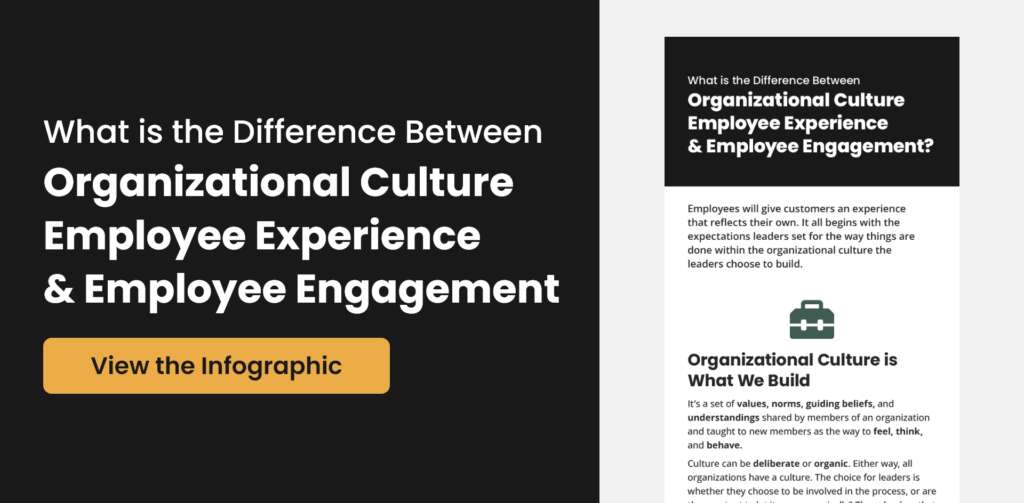What is Your Organization’s Employee Experience?
Unlock the power of organizational culture to shape an Employee Experience that fosters robust engagement. Explore our guide for actionable insights and optimize your workplace dynamics.

Crafting Optimal Employee Experiences: A Definitive Guide
“Demystify Employee Experience (EX) – the amalgamation of employee perceptions and organizational interactions. Explore how employees view their workplace culture and foster a positive EX. Dive into a clearer understanding of EX with straightforward insights.
When we measure EX, we are hoping to answer this simple question: “What’s it like to work at this particular place?””
Navigating Organizational Culture vs. Employee Experience Dynamics
Dive into the distinct realms of Employee Experience (EX) and Organizational Culture, interconnected yet deserving separate recognition. Organizational Culture encapsulates shared values and beliefs, shaping the ethos of a workplace. Whether deliberate or organic, every organization possesses a unique culture. Explore the intricate dynamics that define ‘the way things work’ and understand the pivotal role of Organizational Culture in fostering a cohesive workplace environment.
Discover the essence of Employee Experience (EX) as the collective response and interaction of employees with their organization’s culture. Delve into the nuanced exploration of EX, centered on the crucial perspectives of employees. Recognizing the significance of employee voices, we distinguish and emphasize this concept as the indispensable ‘Employee Experience’ for fostering organizational vitality.
Diving Deeper into Employee Experience Insights
Envision Employee Experience (EX) as the operational backbone, the ‘OS’ for your workforce. An effective EX functions as a magnet, drawing, retaining, and engaging employees. Our surveys meticulously assess EX at every lifecycle stage, from onboarding to pulse surveys and exit surveys, ensuring a comprehensive understanding and optimization of your organizational ‘OS’ for sustained success.
Unlocking Employee Experience (EX) success hinges on aligning expectations with actual employee experiences. In our research for ‘The Employee Experience: How to Attract Talent, Retain Top Performers, and Drive Results,’ we analyzed 40 million survey responses. We developed this equation as a result of what we found:
Crafting an exceptional Employee Experience extends beyond superficial perks and claims of being a ‘great place to work.’ While such tactics may yield short-term results, they often lose their impact over an employee’s journey. A robust Employee Experience survey guides organizations towards a more sustainable approach, offering each employee a meaningful purpose, a clear path, and a genuine sense of belonging.
Where does Employee Engagement fit into things? What about Employee Well-Being?
Elevate Employee Engagement through a meticulously designed Employee Experience survey. Aligning Employee Experience with organizational and employee needs results in heightened workforce engagement. Explore the powerful connection between a strategic Employee Experience survey and the positive outcomes of elevated Employee Engagement within the organization.
Elevate Employee Engagement through a comprehensive Employee Experience survey. Employee Engagement is the emotional commitment that fuels passion and energy at work, leading to employees investing their best selves in their tasks. A purposeful Employee Experience, encompassing a sense of purpose, clear path, and a meaningful place within the organization, cultivates a sense of belonging. Discover the keys to fostering automatic and sustained Employee Engagement with our insightful Employee Experience survey.
Distinguish Employee Engagement from Employee Well-Being with our comprehensive Employee Experience survey. While Well-Being centers on ‘feeling good’ and overall happiness, Employee Engagement goes beyond, focusing on how the job impacts an employee’s health and happiness. Our survey delves into the nuanced dynamics, recognizing that fostering engaged employees goes beyond mere happiness. Discover the keys to eliciting focused contributions and discretionary effort through a strategic Employee Experience survey for organizational success.
Optimize EX management with our strategic approach. Many organizations prioritize happiness but overlook crucial elements like belonging, growth, individual development, meaning, and impact. Elevate your Employee Experience with our comprehensive survey, addressing the full equation for lasting success.
What is Employee Satisfaction?
Explore the nuances of Employee Satisfaction within the Employee Experience. Foundational elements like safety, tools, perks, recognition, and compensation are crucial for the employee-organization relationship. While not direct motivators, these transactional elements are vital. Discover the impact of these factors on employee engagement with our specialized Employee Experience survey, ensuring a workplace where employees are motivated and bring their best selves to work.
Uncover the significance of Employee Satisfaction within the broader Employee Experience. While transactional, it forms the foundational ‘this-for-that’ relationship crucial for employee engagement. Imagine it like a bank account – consistent deposits of compensation, workplace satisfaction, benefits, and safety lead to an employee willing to contribute effort proportionate to these deposits. Explore this symbiotic relationship with our specialized Employee Experience survey for a workplace that thrives on mutual satisfaction and contribution.
Essential Insight: Employee Satisfaction lays the groundwork for comprehensive EX initiatives, including growth and individual development plans. Our specialized Employee Experience survey empowers organizations to enhance Satisfaction as a pivotal starting point for fostering a thriving workplace.
The Employee Experience Summarized
Navigate the nuances of Organizational Culture, Employee Experience, and Employee Engagement with precision. Think of it as a trilogy: Organizational culture is the foundation we build, EX is the meticulously measured metric, and Employee Engagement is the coveted outcome. Explore this dynamic trio with our insightful Employee Experience survey for strategic organizational success.
Your Employee Experience strategy should be designed to do the following:
- Measure and understand how your employees experience your organizational culture (employee experience surveys)
- Align your EX to the mission and values of your organization (what behaviors should you expect from your leaders)
- Use an Employee Experience platform or other system to continually monitor the overall health and effectiveness of your EX
- Use data and insights to guide operational leaders
- Teach front-line leaders the important of helping each employee find a purpose, path, and pace within your organization (Leader Driven Experience)
More on the Employee Experience
Elevate Success: Mastering the Employee Experience Advantage
Presented by: Christian Nielson and Matthew Wride






